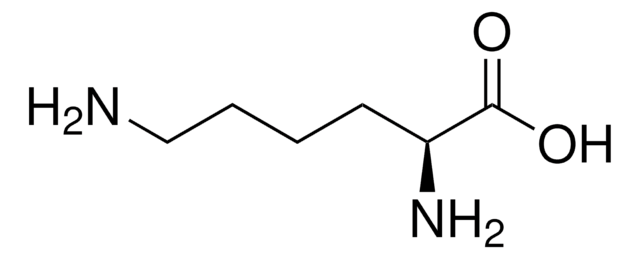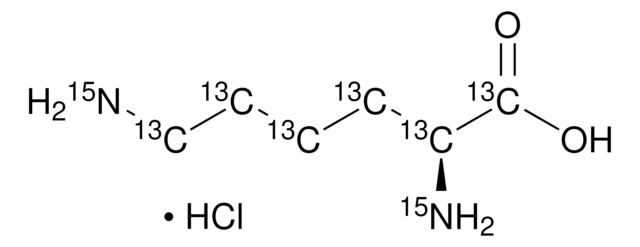L5751
L-Lysine dihydrochloride
≥98% (HPLC), suitable for ligand binding assays
Sinonimo/i:
(S)-2,6-Diaminohexanoic acid dihydrochloride
About This Item
Prodotti consigliati
Nome del prodotto
L-Lysine dihydrochloride, ≥98% (HPLC)
Livello qualitativo
Saggio
≥98% (HPLC)
Stato
powder
tecniche
ligand binding assay: suitable
Colore
white to faint yellow
Punto di fusione
200-206 °C (lit.)
Stringa SMILE
Cl[H].Cl[H].NCCCC[C@H](N)C(O)=O
InChI
1S/C6H14N2O2.2ClH/c7-4-2-1-3-5(8)6(9)10;;/h5H,1-4,7-8H2,(H,9,10);2*1H/t5-;;/m0../s1
JBBURJFZIMRPCZ-XRIGFGBMSA-N
Cerchi prodotti simili? Visita Guida al confronto tra prodotti
Azioni biochim/fisiol
Codice della classe di stoccaggio
11 - Combustible Solids
Classe di pericolosità dell'acqua (WGK)
WGK 3
Punto d’infiammabilità (°F)
Not applicable
Punto d’infiammabilità (°C)
Not applicable
Dispositivi di protezione individuale
Eyeshields, Gloves, type N95 (US)
Scegli una delle versioni più recenti:
Possiedi già questo prodotto?
I documenti relativi ai prodotti acquistati recentemente sono disponibili nell’Archivio dei documenti.
I clienti hanno visto anche
Il team dei nostri ricercatori vanta grande esperienza in tutte le aree della ricerca quali Life Science, scienza dei materiali, sintesi chimica, cromatografia, discipline analitiche, ecc..
Contatta l'Assistenza Tecnica.






